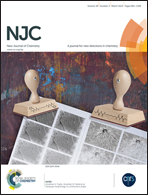Charge transfer facilitated direct electrophilic substitution in phenylaminonaphthoquinones: experimental, theoretical and electrochemical studies†
Abstract
A simple and effective synthetic protocol to introduce electron withdrawing substitutents (Br and NO2) in the phenyl ring of 2-(p-R-phenylamino)-3-chloro-1,4-naphthoquinones (where R = H, Me, OMe, F and Cl; 1a–e) has been demonstrated using the phenomenon of intermolecular charge transfer (CT) complexation as a catalyst. These compounds were subjected to direct bromination (using Br2) and nitration (using NO2BF4) in the presence of hexamethyl benzene (HMB) as an electron donor partner in the formation of CT complexes with 1a–e. The results indicated that the quinone–HMB adduct is more susceptible to direct electrophilic substitution than the quinone alone. It was observed that there is a tremendous increase in the yield of the products. 1H and 13C NMR, 1H–H COSY, 1H NOSEY and LC-MS spectral analysis of the products indicated that the directing influence of the NH group plays a major role in determining the orientation in the substitution reactions. Density functional theory and electrochemical studies were also carried out to substantiate the proposed mechanism. A preliminary study on the anti-oxidant and anti-bacterial properties of the reactants and the products was also carried out.


 Please wait while we load your content...
Please wait while we load your content...